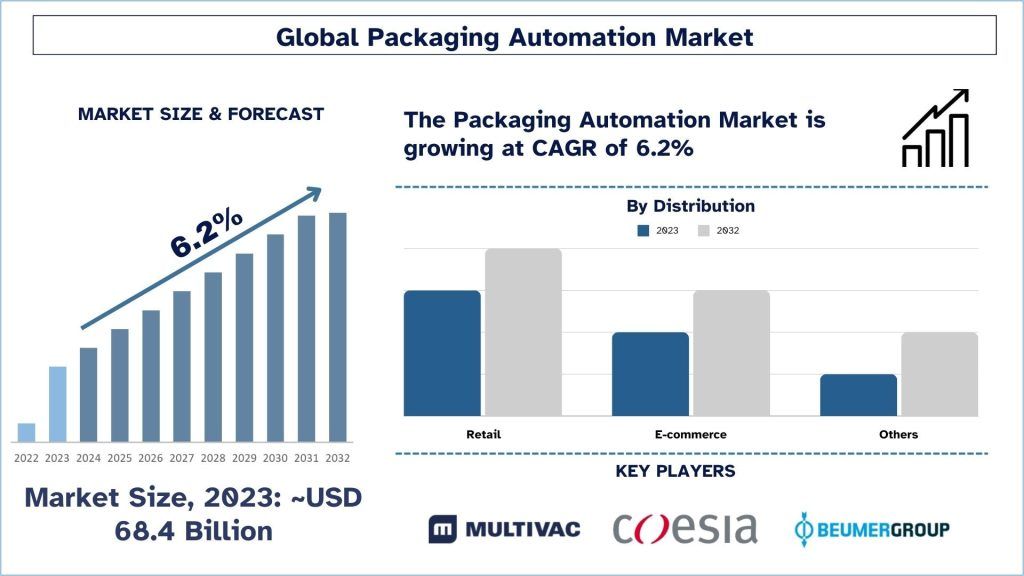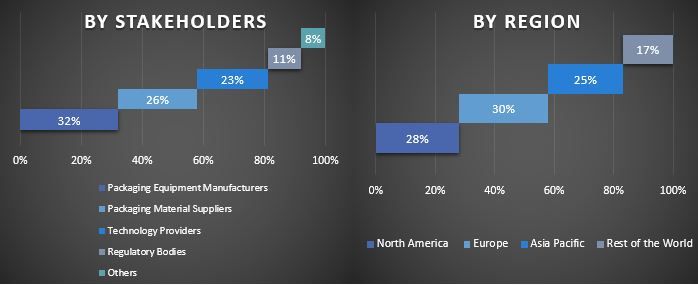- Home
- About Us
- Industry
- Services
- Reading
- Contact Us
Packaging Automation Market: Current Analysis and Forecast (2024-2032)
Emphasis on Product Type (Filling Machine, Labelling, Palletizing, Wrapping, And Others); End-Use (Food & Beverages, Healthcare, Personal Care, and Others); Distribution (Retail, E-commerce, and Others); and Region/Country
Global Packaging Automation Market Size & Forecast
The global packaging automation market was valued at USD 68.4 billion in 2023 and is expected to grow at a strong CAGR of around 6.2% during the forecast period (2024-2032) owing to increased consumer demand for packaged food, beverages, pharmaceuticals, and personal care products drives the need for automation in packaging processes.
Packaging Automation Market Analysis
The global Packaging Automation Market can be described as the process of employing automated equipment and technologies in packaging solutions that are used across a multitude of industries such as food and beverages, pharmaceuticals, consumer goods, and other related sectors. These systems include filling, sealing, labeling, palletizing, and wrapping, which enhance the production efficiency in each production line, minimize the cost of labor, and enhance the standard and quality of the products. The market is growing at a very fast pace due to factors like increased consumption of packaged products due to increased urbanization and changes in consumers’ lifestyles, increased e-commerce sales, and the increasing focus on environment-friendly packaging. Besides, the growth of AI and IoT technologies is also driving market growth by improving the efficiency of packaging processes.
Global Packaging Automation Market Trends
This section discusses the key market trends that are influencing the various segments of the global packaging automation market, as identified by our team of research experts.
Food & Beverages Segment Transforming Industry
This is because the industry requires high efficiency, safety, and hygiene standards in the packaging process, among other factors. In this sector automated systems assist in the packaging process by improving the quality, minimizing the effect of human interference, and ensuring product safety. The current trends in the packaged food products market the development of online sales and the concern regarding the environment require Also, food packaging integrity preservation that is governed by the Food and Drug Administration (FDA) standards makes the automation crucial.
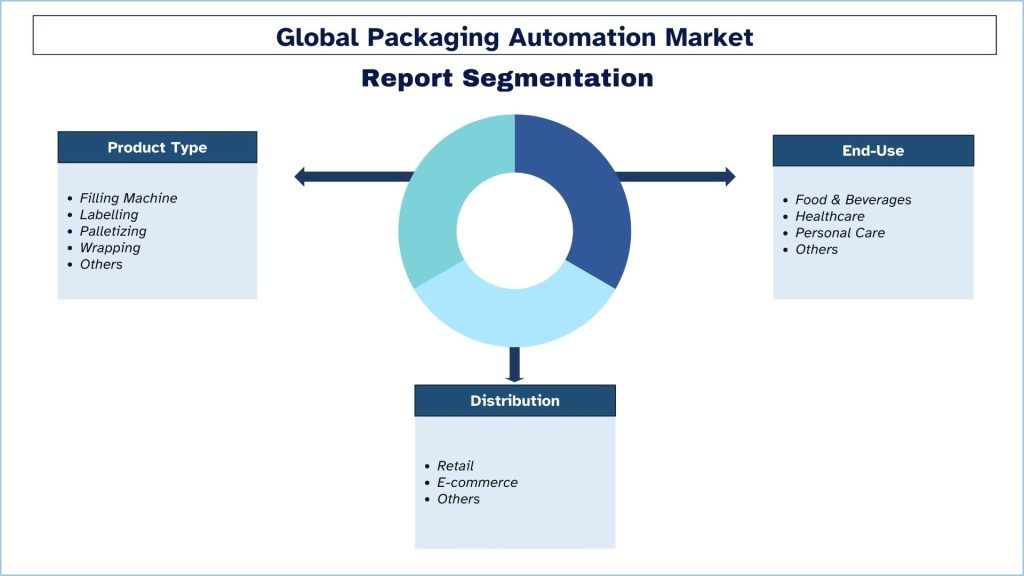
North America is Expected to Grow at the significant CAGR During Forecast Period.
North America Packaging Automation Market refers to the technologies and systems applied in the packaging process of various products like food and beverage, pharmaceutical, cosmetics, and consumer goods. This market is driven by using a high level of technology in packaging processes like robotics, artificial intelligence, IoT, etc., to increase efficiency, accuracy, and flexibility in packaging. The major force that is driving the growth of the market includes the rising need for efficient packaging solutions due to the growth in the e-commerce industry, the need to minimize the cost of labor, and the focus on environmentally friendly packaging. Also, increased emphasis on product safety and regulation compliance and increased focus on the safety and quality of products contributes to the growth of the automated packaging solutions market in North America.
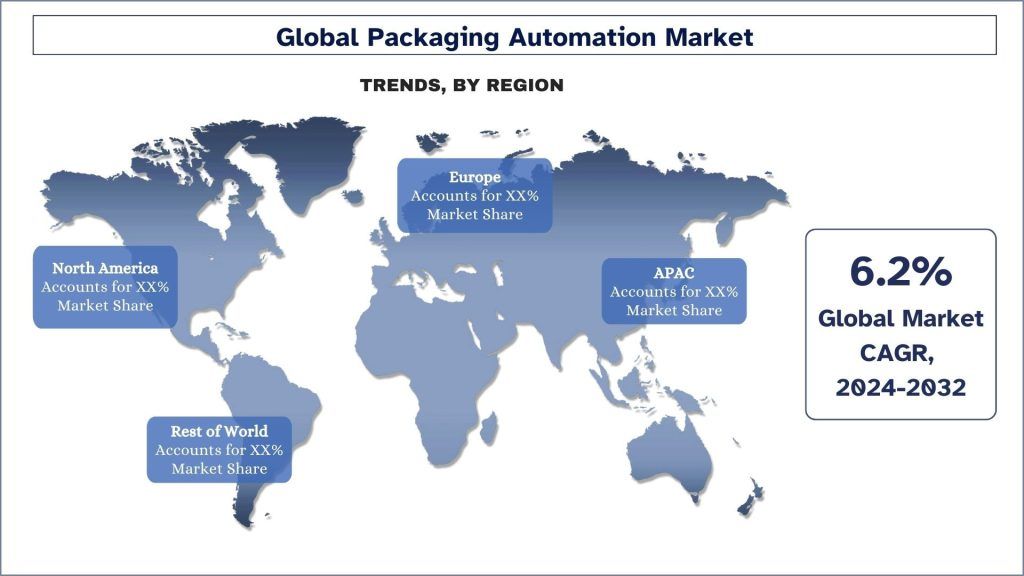
Global Packaging Automation Industry Overview
The global Packaging Automation market is competitive, with several global and international market players. The key players are adopting different growth strategies to enhance their market presence, such as partnerships, agreements, collaborations, new product launches, geographical expansions, and mergers and acquisitions. Some of the major players operating in the market are MULTIVAC Sepp Haggenmüller SE & Co. KG; Coesia S.p.A.; ULMA GROUP; Syntegon Technology GmbH; Swisslog Healthcare; Rockwell Automation; Sealed Air; Mitsubishi Electric Automation, Inc.; BEUMER Group; WestRock Linkx Systems Ltd
Global Packaging Automation Market Report Coverage
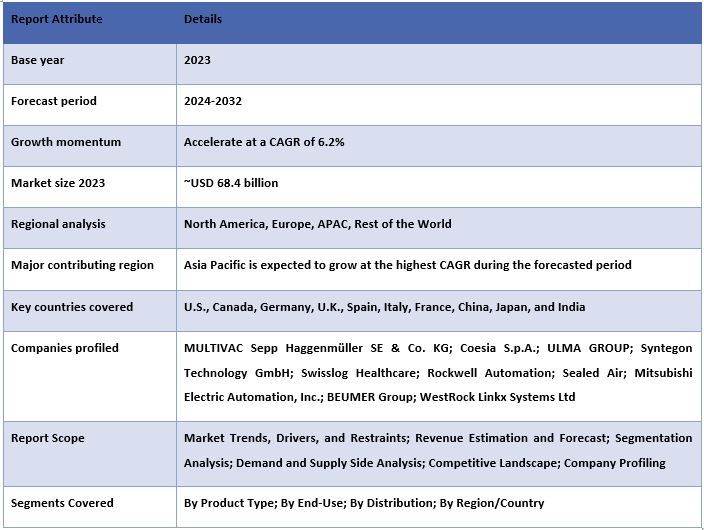
Reasons to buy this report:
- The study includes market sizing and forecasting analysis validated by authenticated key industry experts.
- The report briefly reviews overall industry performance at one glance.
- The report covers an in-depth analysis of prominent industry peers with a primary focus on key business financials, type portfolios, expansion strategies, and recent developments.
- Detailed examination of drivers, restraints, key trends, and opportunities prevailing in the industry.
- The study comprehensively covers the market across different segments.
- Deep dive regional level analysis of the industry.
Customization Options:
The global packaging automation market can further be customized as per the requirement or any other market segment. Besides this, UMI understands that you may have your own business needs, hence feel free to contact us to get a report that completely suits your requirements.
Table of Content
Research Methodology for the Global Packaging Automation Market Analysis (2024-2032)
Analyzing the historical market, estimating the current market, and forecasting the future market of the global Packaging Automation market were the three major steps undertaken to create and analyze the adoption of global Packaging Automation in major regions. Exhaustive secondary research was conducted to collect the historical market numbers and estimate the current market size. Secondly, to validate these insights, numerous findings and assumptions were considered. Moreover, exhaustive primary interviews were conducted with industry experts across the value chain of the global Packaging Automation market. For the assumption and validation of market numbers through primary interviews, we employed a top-down/bottom-up approach to forecasting the complete market size. Thereafter, market breakdown and data triangulation methods were adopted to estimate and analyze the market size of segments and sub-segments of the industry pertains to. Detailed methodology is explained below:
Analysis of Historical Market Size
Step 1: In-Depth Study of Secondary Sources:
A detailed secondary study was conducted to obtain the historical market size of the global Packaging Automation market through company internal sources such as annual reports & financial statements, performance presentations, press releases, etc., and external sources including journals, news & articles, government publications, competitor publications, sector reports, third-party database, and other credible publications.
Step 2: Market Segmentation:
After obtaining the historical market size of the global Packaging Automation market, we conducted a detailed secondary analysis to gather historical market insights and share for different segments & sub-segments for major regions. Major segments are included in the report as product type, end-use, distribution, and regions. Further country-level analyses were conducted to evaluate the overall adoption of testing models in that region.
Step 3: Factor Analysis:
After acquiring the historical market size of different segments and sub-segments, we conducted a detailed factor analysis to estimate the current market size of the global Packaging Automation market. Further, we conducted factor analysis using dependent and independent variables such as Product type, end-use, distribution, and global Packaging Automation market regions. A thorough analysis of demand and supply-side scenarios was conducted considering top partnerships, mergers and acquisitions, business expansion, and product launches in the global Packaging Automation market.
Current Market Size Estimate & Forecast
Current Market Sizing: Based on actionable insights from the above 3 steps, we arrived at the current market size, key players in the global Packaging Automation market, and market shares of the segments. All the required percentage shares split, and market breakdowns were determined using the above-mentioned secondary approach and were verified through primary interviews.
Estimation & Forecasting: For market estimation and forecast, weights were assigned to several factors including drivers & trends, restraints, and opportunities available for the stakeholders. After analyzing these factors, relevant forecasting techniques i.e., the top-down/bottom-up approach were applied to arrive at the market forecast 2032 for different segments and sub-segments across the major markets globally. The research methodology adopted to estimate the market size encompasses:
- The industry’s market size, in terms of revenue (USD) and the adoption rate of the global Packaging Automation market across the major markets domestically
- All percentage shares, splits, and breakdowns of market segments and sub-segments
- Key players in the global Packaging Automation market in terms of types offered. Also, the growth strategies adopted by these players to compete in the fast-growing market
Market Size and Share Validation
Primary Research: In-depth interviews were conducted with the Key Opinion Leaders (KOLs) including Top Level Executives (CXO/VPs, Sales Head, Marketing Head, Operational Head, Regional Head, Country Head, etc.) across major regions. Primary research findings were then summarized, and statistical analysis was performed to prove the stated hypothesis. Inputs from primary research were consolidated with secondary findings, hence turning information into actionable insights.
Split of Primary Participants in Different Regions
Market Engineering
The data triangulation technique was employed to complete the overall market estimation and to arrive at precise statistical numbers for each segment and sub-segment of the global Packaging Automation market. Data was split into several segments and sub-segments after studying various parameters and trends in the global Packaging Automation market’s product type, end-use, distribution, and regions.
The Main Objective of the Global Packaging Automation Market Study
The current & future market trends of the global Packaging Automation market were pinpointed in the study. Investors can gain strategic insights to base their discretion for investments on the qualitative and quantitative analysis performed in the study. Current and future market trends determined the market’s overall attractiveness at a regional level, providing a platform for the industrial participant to exploit the untapped market to benefit from a first-mover advantage. Other quantitative goals of the studies include:
- Analyze the current and forecast market size of the global Packaging Automation market in terms of value (USD). Also, analyze the current and forecast market size of different segments and sub-segments.
- Segments in the study include areas of the Product Type, end-use, distribution, and regions.
- Define and analyze the regulatory framework for the industry.
- Analyze the value chain involved with the presence of various intermediaries, along with analyzing customer and competitor behaviors of the industry.
- Analyze the current and forecast market size of the global Packaging Automation market for the major regions.
- Major countries of regions studied in the report include Asia Pacific, Europe, North America, and the Rest of the World
- Company profiles of the global Packaging Automation market and the growth strategies the players adopt to sustain in the fast-growing market.
- Deep dive regional level analysis of the industry
Frequently Asked Questions FAQs
Q1: What is the global Packaging Automation market’s current market size and growth potential?
Q2: What are the driving factors for the growth of the global Packaging Automation market?
Q3: Which segment has the largest share of the global packaging automation market by product type category?
Q4: What are the emerging technologies and trends in the global Packaging Automation market?
Q5: Which region will dominate the global Packaging Automation market?
Related Reports
Customers who bought this item also bought

